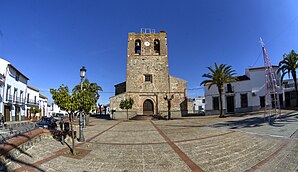Hinojosa del Valle
| Hinojosa del Valle municipality | ||
|---|---|---|
 Hinojosa del Valle - townscape with church
|
||
| coat of arms | Map of Spain | |

|
|
|
| Basic data | ||
| Autonomous Community : | Extremadura | |
| Province : | Badajoz | |
| Comarca : | Tierra de Barros | |
| Coordinates | 38 ° 29 ′ N , 6 ° 11 ′ W | |
| Height : | 445 msnm | |
| Area : | 46.03 km² | |
| Residents : | 483 (Jan. 1, 2019) | |
| Population density : | 10.49 inhabitants / km² | |
| Postal code : | 06226 | |
| Municipality number ( INE ): | 06068 | |
| administration | ||
| Website : | Hinojosa del Valle | |
Hinojosa del Valle is a place and a municipality ( municipio ) with 483 inhabitants (as of 2019) in the center of the Spanish province of Badajoz in the autonomous community of Extremadura .
location
The place Hinojosa del Valle is located on the northern edge of the Sierra Morena a good 94 km southeast of the provincial capital Badajoz or a good 63 km southeast of Mérida at an altitude of about 445 m above sea level. d. The climate in winter is temperate, in summer it is warm to hot; the rather low amounts of precipitation (approx. 570 mm / year) fall - with the exception of the almost rainless summer months - distributed over the whole year.
Population development
| year | 1857 | 1900 | 1950 | 2000 | 2016 |
| Residents | 543 | 670 | 1,481 | 610 | 503 |
The significant population decline in the second half of the 20th century is mainly due to the mechanization of agriculture and the resulting loss of jobs.
economy
The people of earlier centuries lived essentially as self-sufficiency from agriculture; Traders, craftsmen and service providers of all kinds also settled in the village.
history
Archaeological traces from prehistory as well as from Celts, Romans and Visigoths are missing. In the early 8th century the region was overrun by the Moors , who settled under the Leonese King Alfonso IX around 400 years later . (r. 1188-1230) with Christian reconquest aspirations for the first time ( reconquista ) had come to terms, but from the Almohad to the Battle of Las Navas de Tolosa was stopped (1212). The final reconquest of the southwest of the Iberian Peninsula took place under the Leonese-Castilian King Ferdinand III. (reg. 1230-1252). In 1235 he handed the place over to the Order of Santiago , who pursued a rather tolerant policy towards Jews and Muslims . With the Alhambra Edict of the Catholic Kings Isabella I and Ferdinand II , all Jews who had not converted were initially expelled from Spain; under Philip III. (ruled 1598–1621) and his first minister, the Duke of Lerma , also expelled the Moors (or Moriscus ) between 1609 and 1615 .
Attractions
- The portals and the bell storey of a battlement who built the final tower in the 16th century from a mixture of breaking and bricks Iglesia de Nuestra Señora de los Ángeles are walled entirely of bricks. The core of the plastered pillars and arches in the three-aisled interior of the church are also made of masonry bricks, which are plastered by the painting of the joints and the alternating white-gray coloring . The nave is barrel vaulted while the apse has a rib vault .
- Distributed in Several roadside crosses and some wells whose basin as cattle troughs (abrevaderos) served.
Web links
- Hinojosa del Valle, sights - photos + brief information (spanish)
- Hinojosa del Valle, history etc. - photos + information (Spanish)
Individual evidence
- ↑ Cifras oficiales de población resultantes de la revisión del Padrón municipal a 1 de enero . Population statistics from the Instituto Nacional de Estadística (population update).
- ↑ Hinojosa del Valle - map with altitude information
- ↑ Hinojosa del Valle - climate tables
- ↑ Hinojosa del Valle - population development
